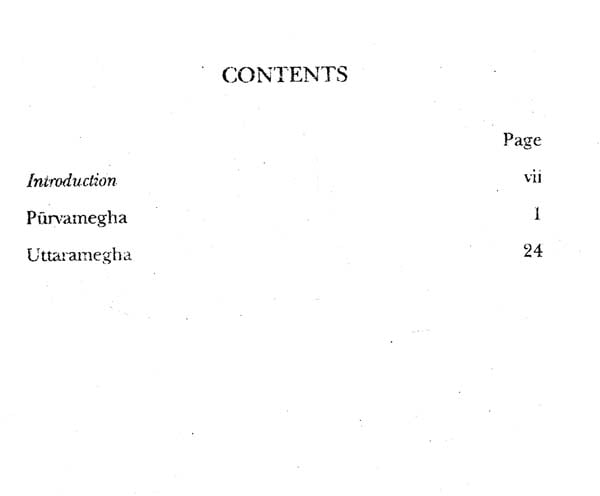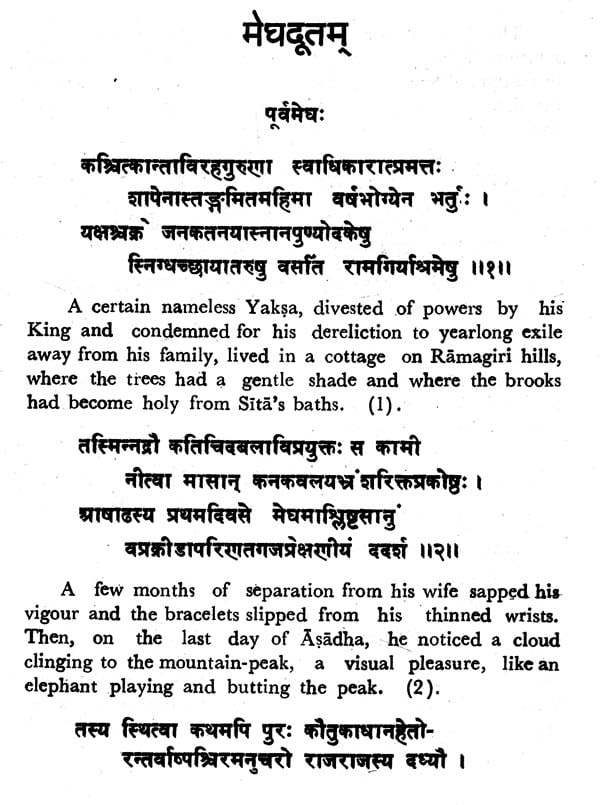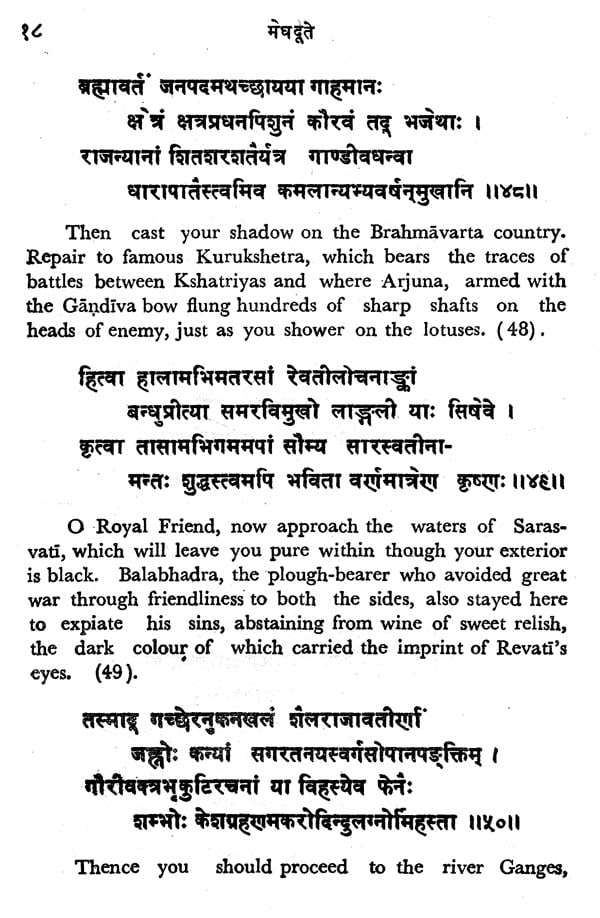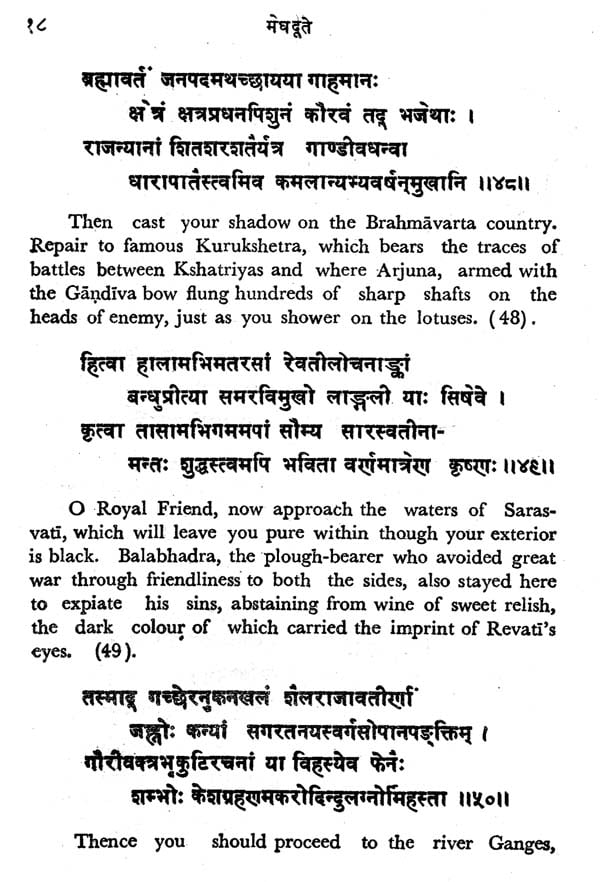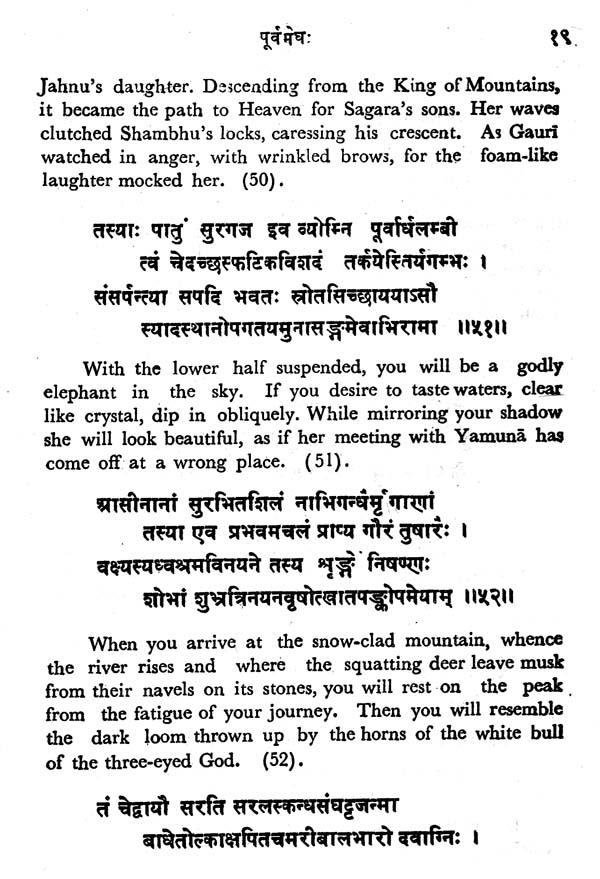
Meghaduta of Kalidasa
Book Specification
| Item Code: | NAX338 |
| Author: | C. R. Devadhar |
| Publisher: | MOTILAL BANARSIDASS PUBLISHERS PVT. LTD. |
| Language: | Sanskrit Text with English Translation |
| Edition: | 2015 |
| ISBN: | 9788120800168 |
| Pages: | 43 |
| Cover: | PAPERBACK |
| Other Details | 7.00 X 4.50 inch |
| Weight | 50 gm |
Book Description
In this poem, Kalidasa gives us a glimpse of Kailasa, and the Himalayan regions. His eye in a fine frenzy rolls over the ridges, cliffs, scarps, valleys, dales, glades and the gritty upland of that mountain. He delineates the story of a bereaved Yaksa in crystal-clear vignettes that are remarkable for their precision and romantic charm.
PURVAMEGHA
In the Purvamegha the poet reveals the Yaksa facing a cloud, clasping a towering peak of Himalayas, whom he thinks of making the bearer of a message to his lorn wife; for he was cursed by Kuvera his Lord, to be severed from his wife for dereliction of duty. He makes an offering of Kutaja flowers and water to the cloud. He addresses the cloud thus :-
"In the farfamed house of Puskara and
Avartaka clouds art thou born.
And with wonder - waiting eyes,
The wayfarers' wives will look at
Thee confidently, holding the ends of
Their dishevelled tresses.
Then he describes to the cloud, on his journey to distant Alaka, the way he is to take to reach that city. He is to take a northerly course in his flight. Soon he shall meet mount Amrakuta fringed on its skirts by mango groves. "Going further on, thou shalt see Reva, split into tiny streams on the uneven rocks of the Vindhya; then thou shalt reach the Dasarna country. Next, thou shalt meet Vidisa, the far-famed capital, and shalt drink the waters of Vetravati. Sojourn makest thou on mount Nicala and spill thy waters on the jasmine bowers on her banks. Although the way is circuitous for thee, set out to the north. Fail not to visit Ujjayini, this piece of heaven on the earth, with her flowers, sweet balconies and her black-eyed maidens, and the dread temple of Mahakala. Going across Sindhu, you will meet Nirvindhya. Your reflection, so lovely by nature, will be imaged in the deep waters of the Gambhira. Hie thee to Devagiri, where dwelleth Skanda, and bathe him with a shower of flowers. Propitiate the god of reeds, and honour Rantideva's renown in the form of the river Carmanvati, and cross that river and make thy form an object of curiosity to the eyes of the ladies of Dasapura. Dive into the country of Brahmavarta, and repair to that Kuruksetra, which bears the traces of a fierce battle between the Ksatriyas.
Beyond the ridges of the home of snow, hie thee through Kraunca's gate, athwart the snowy mountain.
While upward, thou rushest, where the peaks of Kailasa are torn apart by the puissant arms of Ravana.
To the heavenly fair serve as a mirror; where they rear aloft their lofty heads, they shine as a lotus, whose white hue is like laughter loud of Siva's mouth. Enjoy a drink of the waters of Manasa lake, where the lilies golden bloom, and proceed to Alaka fair."
Here we have a very mature piece of poetry worthy of the epic poet. The theme, apparently suggested by the sequestration of pining Rama described in Ramayana, is handled in an original manner. The personification of cloud serves many purposes, which are ingeniously exploited. First, a pining heart could not choose a more speedy messenger to convey his ardent message to his distant beloved than the fast racing rain cloud. Besides, at the approach of the rainy season, the propensity of the loving and longing young souls to get lost in clouds makes the last the most apt vehicles of unfulfilled dreams and fancies. Again, at one stroke, the device of personification well serves the development of the theme of human love and affords the reader the vicarious joy of seeing, 'en direct' as it were the unfolding of the landscape as the cloud floats north-ward. The beauty and brilliance of description reach unique heights and are unsurpassed in their power to evoke sentiment. Rare would be a reader who did not secretly seek to identify himself with the cloud, thus showing a measure of his sympathy for the Yaksa Indeed, the success of the device of personification lies in such feeling of identification. Further, it is this feeling evoked in the mind of the reader which creates a living character out of the cloud and sustains its friendly and noble role in this lyric or lyrics.
**Contents and Sample Pages**
